Here’s the thing: America loves baseball cards.
For 70 years, the Topps Company documented every season, every team, and every player of America’s National Pastime on flimsy little 2.5 by 3.5-inch pieces of board. Every passing generation has had its icons immortalized for the purpose of trading amongst fans and collectors. The names and uniforms may change, but the cards remain the same size and shape. And for the most part, they contain the same stats and information. So, why is it that a T206 Honus Wagner card just sold for $6.606 million when most aren’t worth a pack of gum?
Ah, to be non-fungible.
If something is fungible, it is interchangeable with equally valuable assets. Any individual twenty-dollar bill can be exchanged for another just like it (or two tens, four fives, twenty ones, 2,000 pennies, etc.) while maintaining the same value: twenty 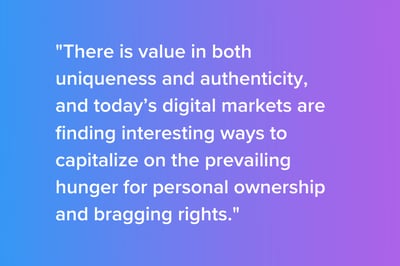 dollars. Conversely, something non-fungible cannot be exchanged with similar goods or assets, as each individual item is inherently different. A 4,000 square foot home in Beverly Hills is not valued the same as a 4,000 square foot home in Cleveland. (No offense, Ohio! The heart of rock and roll is in Cleveland!) And going back to our baseball analogy, a Honus Wagner card with an authentic autograph cannot be valued the same as one without. Nor can you expect the world to look at your child’s finger painting the same way they look at the Mona Lisa (though I’m sure your child is very good). There is value in both uniqueness and authenticity, and today’s digital markets are finding interesting ways to capitalize on the prevailing hunger for personal ownership and bragging rights.
dollars. Conversely, something non-fungible cannot be exchanged with similar goods or assets, as each individual item is inherently different. A 4,000 square foot home in Beverly Hills is not valued the same as a 4,000 square foot home in Cleveland. (No offense, Ohio! The heart of rock and roll is in Cleveland!) And going back to our baseball analogy, a Honus Wagner card with an authentic autograph cannot be valued the same as one without. Nor can you expect the world to look at your child’s finger painting the same way they look at the Mona Lisa (though I’m sure your child is very good). There is value in both uniqueness and authenticity, and today’s digital markets are finding interesting ways to capitalize on the prevailing hunger for personal ownership and bragging rights.
At the center of this conversation is the inimitable “NFT,” or non-fungible token. So, what’s an NFT, exactly? In plain terms, they are tokens that house or store these unique valuables. Collectibles. Concert tickets. Domain names. Your brain patterns, scanned into a computer and turned into AI (the future is going to be wild, huh?) These unique digital tokens carry unique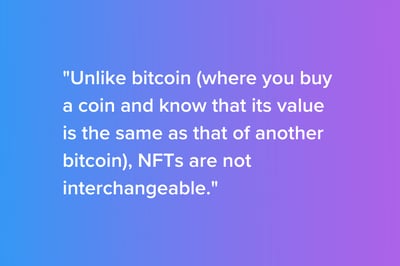 value, and they all (even the ones linked to physical objects) exist on the blockchain for the purposes of proving ownership (read our blog for more). Each of these non-fungible tokens has a digital singular signature that proves its uniqueness and authenticity. Unlike bitcoin (where you buy a coin and know that its value is the same as that of another bitcoin), NFTs are not interchangeable.
value, and they all (even the ones linked to physical objects) exist on the blockchain for the purposes of proving ownership (read our blog for more). Each of these non-fungible tokens has a digital singular signature that proves its uniqueness and authenticity. Unlike bitcoin (where you buy a coin and know that its value is the same as that of another bitcoin), NFTs are not interchangeable.
While any blockchain can implement its own versions of NFTs, most current instances are part of Ethereum. Currently, much of the excitement around these tokens is based on the use of technology to sell digital art. Perhaps you’ve noticed the legion of leisurely cartoon apes making their presence felt online and in the media. If so, you’ve encountered The Bored Ape Yacht Club (BAYC), a collection of 10,000 unique illustrations hosted on the popular blockchain. The purchase of one of these NFTs grants access to a social club of sorts, both online and in person, with Bored Ape creators hosting live gatherings around the globe for owners. The hysteria surrounding the BAYC is, in many ways, a perfect illustration of our culture’s current fascination with non-fungible tokens—the hype, the potential, and the potential pitfalls. For now, at least, those stultified apes are getting their very own movie trilogy.
And they’re not alone. Studios and networks like Warner Bros., Disney, Lionsgate, Fox, ViacomCBS, and CNN are quickly getting in on the action. There’s money to be made in this new market, which has shown fast-moving development, growing ten-fold between 2018 and 2020. DappRadar estimates that NFT sales for the first half of 2021 added up to $2.47 billion. The total market forecast looks even stronger; more than $35 billion for 2022 and over $80 billion for 2025. This new model has the potential to rewrite entertainment's natural order in the same way that streaming did upon its arrival, and we’re seeing bigger and bigger names steadily enter the NFT arena. The model has already attracted independent filmmakers, who see the NFT as a tool that provides more opportunities for funding and distribution. By giving NFT-holding investors an equitable share of box office revenues, filmmakers can expand and diversify their audience outreach. Current platforms like FF3 and Cineverse have arrived to assist with NFT-centric film funding.
This practice is already yielding results. Zero Contact, a feature film starring Anthony Hopkins, has the honor of being the first full-length movie to be bought and sold on blockchain. Shot over Zoom in 17 different countries throughout the course of the Covid-19 pandemic, the film was eventually released as an NFT via Vuele, a non-fungible token platform. Since its debut, Zero Contact has been acquired by Grindstone Entertainment, securing a May 2022 release in the U.S. Additionally, animated web series like The Glue Factory, are making it so that token holders are vested in their projects, encouraging them to purchase specific NFTs through unique websites to unlock a wide range of benefits and ownership levels. Community projects are even changing the types of films that get made, with one experimental Sundance film allowing participants to collect NFTs that depict various characters and giving them some stake in how the story might unfold.
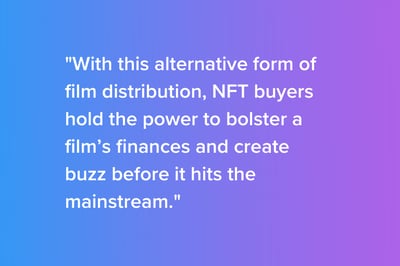 With this alternative form of film distribution, NFT buyers hold the power to bolster a film’s finances and create buzz before it hits the mainstream. And the practical implications stretch into other mediums as well. In the music industry, artists are experimenting with NFTs as a way of enhancing their fanbase experience. Of course, selling an NFT does not mean giving away the proverbial store. Rather than giving away ownership rights with the sale of these tokens, most big artists are using NFTs like digital collectables, with each purchase authenticating that a customer has indeed received a limited-edition item. In the case of musicians, these tokens often include access to download an album. Meaning that a customer’s sole ownership of the NFT collectable grants shared ownership to the artist’s work. Pop group BTS has plans to sell minted pictures of each member, while Grimes has taken to selling her one-of-a-kind artwork. The Kings of Leon took a packaged approach to their latest release, allowing fans who purchased a $50 NFT album in a two-week period to receive a token on the blockchain which grants further access to exclusive moving art, a limited-edition vinyl, and a digital download of the record. In fact, the band made a cool $2 million from the sale. Buying an NFT is akin to buying a rare vinyl print of an album—no more will be made or reproduced. Yes, much of the appeal comes down to pride of ownership, but the market for these new forms of exchange is undeniable, especially considering the potential upside for the artists themselves. Much of an NFT’s appeal to artists comes from the fact that tokens sold through blockchain ensure complete payments—a welcome contrast to platforms like Spotify where musicians make little to no money per play. NFTs can offer artists a bigger upside than standard streaming royalties.
With this alternative form of film distribution, NFT buyers hold the power to bolster a film’s finances and create buzz before it hits the mainstream. And the practical implications stretch into other mediums as well. In the music industry, artists are experimenting with NFTs as a way of enhancing their fanbase experience. Of course, selling an NFT does not mean giving away the proverbial store. Rather than giving away ownership rights with the sale of these tokens, most big artists are using NFTs like digital collectables, with each purchase authenticating that a customer has indeed received a limited-edition item. In the case of musicians, these tokens often include access to download an album. Meaning that a customer’s sole ownership of the NFT collectable grants shared ownership to the artist’s work. Pop group BTS has plans to sell minted pictures of each member, while Grimes has taken to selling her one-of-a-kind artwork. The Kings of Leon took a packaged approach to their latest release, allowing fans who purchased a $50 NFT album in a two-week period to receive a token on the blockchain which grants further access to exclusive moving art, a limited-edition vinyl, and a digital download of the record. In fact, the band made a cool $2 million from the sale. Buying an NFT is akin to buying a rare vinyl print of an album—no more will be made or reproduced. Yes, much of the appeal comes down to pride of ownership, but the market for these new forms of exchange is undeniable, especially considering the potential upside for the artists themselves. Much of an NFT’s appeal to artists comes from the fact that tokens sold through blockchain ensure complete payments—a welcome contrast to platforms like Spotify where musicians make little to no money per play. NFTs can offer artists a bigger upside than standard streaming royalties.
In the colossal gaming industry, Ubisoft has invested in an initiative to sell specialized NFTs for their top games, such as Assassin’s Creed. This practice has shown legs, quickly permeating the gaming community. Avatars, character skins, special weapons, and more are being traded, sold, and re-sold. This model holds a natural appeal to gamers, who have shown that they put a good deal of stock in their online personae. Imagine, for instance, that a rare NFT was offered within Epic Games’ popular title Fortnite—maybe a special character outfit or super-powerful weapon. A player could first take ownership of the new item by unlocking it within the game. Then, they could use the item’s token to resell it to the highest bidder. In this new market, that could mean a lot of money. And that would be good news for Epic Games, who’d stand to take a sizeable cut of each payout in perpetuity.
Sports leagues and athletes are getting in the game as well (some pun intended) with NFT trading cards, games, ticket stubs, and other collectibles being made available to fans. NBA Top Shot, for example, is a line of collectible NFTs that are officially licensed by the league. Each collectible highlights a memorable moment from a professional game or event. NFL All Day does the same for the National Football League. Iconic athletes like Tom Brady have begun producing their own personal NFTs for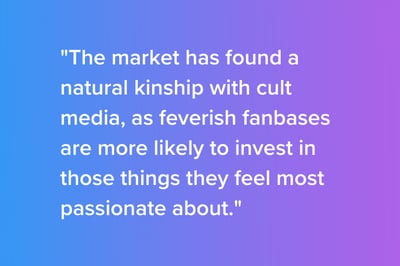 sale. Deloitte predicted that the new sports market will generate over $2 billion in NFT sales just this year. And Tom Brady’s not alone! The famed quarterback has joined the ranks of stars like Bill Murray and Sylvester Stallone, both of whom have produced NFT content for sale. The market has found a natural kinship with cult media, as feverish fanbases are more likely to invest in those things they feel most passionate about. That’s why long-running franchises like Saw and the James Bond series have been able to pull in big NFT profits from their most ardent fans. Even Quentin Tarantino has jumped into the pool, minting parts of his Pulp Fiction screenplay and selling them off as tokens.
sale. Deloitte predicted that the new sports market will generate over $2 billion in NFT sales just this year. And Tom Brady’s not alone! The famed quarterback has joined the ranks of stars like Bill Murray and Sylvester Stallone, both of whom have produced NFT content for sale. The market has found a natural kinship with cult media, as feverish fanbases are more likely to invest in those things they feel most passionate about. That’s why long-running franchises like Saw and the James Bond series have been able to pull in big NFT profits from their most ardent fans. Even Quentin Tarantino has jumped into the pool, minting parts of his Pulp Fiction screenplay and selling them off as tokens.
Online security remains a serious concern to NFT owners, of course. Piracy issues aside (remember them from our blockchain piece?), NFTs have shown their vulnerability to human error and scams, just like any other valuable commodity. While blockchain still provides proof of ownership for these tokens, there is plenty of room for error. As is the nature of any new endeavor, fraud has found its foothold in the market, causing headaches and money loss. Some newer investors have fallen prey to phishing attacks. In one instance, scammers pretending to be buyers from OpenSea (an NFT-purchasing platform) cleared out the wallets of several unfortunate buyers. Others have come across digital forgers who mint and sell art pieces by 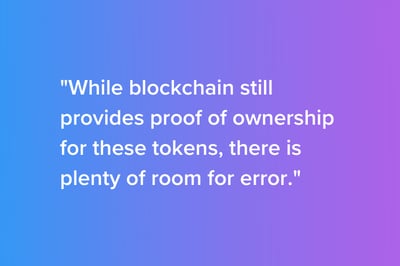 deceased artists. Some NFT marketplaces allow just about anyone to upload images and create NFTs for sale without having to show proof of ownership. Fortunately, blockchain may hold the key to safety advancements by allowing for traceable proprietorship, which helps reduce piracy and art theft. Already, this technology is being used in a myriad of ways, including in the implementation of forensic watermarking and the facilitation of content surveillance. Peer-to-peer oversight has also proven helpful in preventing scams and catching digital criminals, thanks to the decentralization of the community.
deceased artists. Some NFT marketplaces allow just about anyone to upload images and create NFTs for sale without having to show proof of ownership. Fortunately, blockchain may hold the key to safety advancements by allowing for traceable proprietorship, which helps reduce piracy and art theft. Already, this technology is being used in a myriad of ways, including in the implementation of forensic watermarking and the facilitation of content surveillance. Peer-to-peer oversight has also proven helpful in preventing scams and catching digital criminals, thanks to the decentralization of the community.
The creator economy (yep, there’s a blog for that) has been showing that anyone with an idea can monetize their public discourse by generating interesting media that we might forward to our friends for a laugh. For example, YouTube’s seventh-most-watched video of all time, “Charlie Bit Me,” was minted and sold as an NFT by its creator for a staggering $760,999. Standing on the new foundation blockchain has provided, NFTs are the next step toward an evolved form of commerce that eschews traditional rules and middlemen. Want to own access to special concert recordings? How about merchandise, collectibles, and digital art? NFTs are the key. Will a person’s purchased bragging rights eventually fall on deaf ears? For some perspective, the aforementioned $6.6 million sale of that Honus Wagner T206 set a record for baseball card value. In comparison, the Everydays: The First 5000 Days NFT by Mike Winkelmann (known professionally as Beeple) sold for a whopping $69.3 million—the largest single-buyer sale in NFT history as of this writing. And yet, NFTs have been notably decreasing in value these last few months. Time will tell if the allure of personal ownership wears off, but for now, volatile as the market can be, there’s big money and bigger potential in NFTs and blockchain.
.png)
